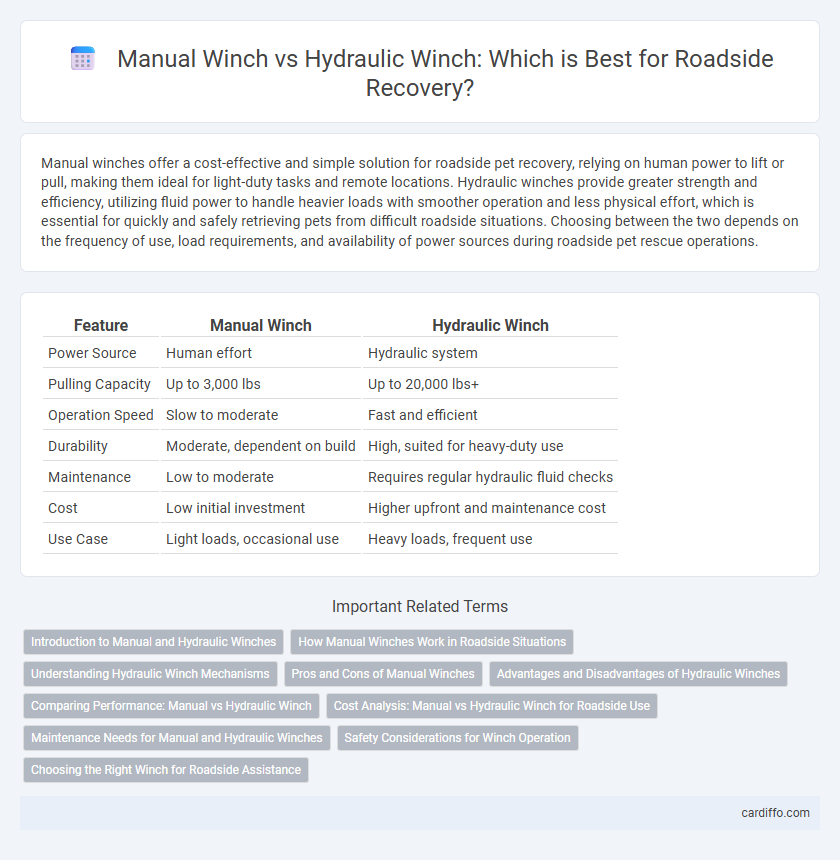Manual winches offer a cost-effective and simple solution for roadside pet recovery, relying on human power to lift or pull, making them ideal for light-duty tasks and remote locations. Hydraulic winches provide greater strength and efficiency, utilizing fluid power to handle heavier loads with smoother operation and less physical effort, which is essential for quickly and safely retrieving pets from difficult roadside situations. Choosing between the two depends on the frequency of use, load requirements, and availability of power sources during roadside pet rescue operations.
Table of Comparison
| Feature | Manual Winch | Hydraulic Winch |
|---|---|---|
| Power Source | Human effort | Hydraulic system |
| Pulling Capacity | Up to 3,000 lbs | Up to 20,000 lbs+ |
| Operation Speed | Slow to moderate | Fast and efficient |
| Durability | Moderate, dependent on build | High, suited for heavy-duty use |
| Maintenance | Low to moderate | Requires regular hydraulic fluid checks |
| Cost | Low initial investment | Higher upfront and maintenance cost |
| Use Case | Light loads, occasional use | Heavy loads, frequent use |
Introduction to Manual and Hydraulic Winches
Manual winches operate using human power, typically through a crank handle that pulls a cable or rope to lift or move heavy loads. Hydraulic winches rely on fluid pressure generated by a hydraulic pump, providing greater pulling power and durability, suitable for demanding roadside recovery tasks. Both types are essential for vehicle recovery, with manual winches favored for portability and hydraulic winches preferred for high-capacity towing.
How Manual Winches Work in Roadside Situations
Manual winches in roadside situations operate through a hand-crank mechanism that allows users to exert controlled force to pull or lift heavy objects, such as immobilized vehicles or debris. Their mechanical advantage is achieved via gears and a spool, enabling effective load management without the need for external power sources. This reliability and simplicity make manual winches essential tools for roadside recovery when electrical or hydraulic options are unavailable.
Understanding Hydraulic Winch Mechanisms
Hydraulic winches operate using pressurized fluid to generate powerful, consistent pulling force ideal for heavy-duty roadside recovery tasks. Their mechanisms include a hydraulic pump driven by the vehicle's engine, directing fluid through valves to a motor that spins the winch drum with high torque and smooth control. This system offers superior durability and load capacity compared to manual winches, making hydraulic models essential for efficiently handling large vehicles and tough terrain.
Pros and Cons of Manual Winches
Manual winches offer a cost-effective and lightweight solution for roadside recovery, requiring no external power source, which makes them highly reliable in remote or emergency situations. However, their limited pulling capacity and slower operation compared to hydraulic winches can hinder efficiency in heavy-duty or prolonged use. Maintenance is minimal, but physical effort is necessary, making manual winches less ideal for frequent or large-scale recovery tasks.
Advantages and Disadvantages of Hydraulic Winches
Hydraulic winches provide higher pulling power and improved durability, making them ideal for heavy-duty roadside recovery tasks requiring continuous operation. Their advantages include efficient performance under load, minimal maintenance, and resistance to overheating, but they require a reliable hydraulic system and can be more complex and expensive to install compared to manual winches. Disadvantages also involve potential hydraulic leaks and the need for skilled operation, limiting their use in situations where simplicity and portability are prioritized.
Comparing Performance: Manual vs Hydraulic Winch
Manual winches offer reliable, low-cost performance with minimal maintenance, ideal for light to moderate tasks due to their mechanical simplicity and ease of use. Hydraulic winches provide superior pulling power, faster operation, and increased durability, making them suitable for heavy-duty roadside recovery and industrial applications. Choosing between manual and hydraulic winches depends on load requirements, power availability, and operational speed needed during vehicle recovery or roadside assistance.
Cost Analysis: Manual vs Hydraulic Winch for Roadside Use
Manual winches typically cost between $100 and $300, making them a budget-friendly option for roadside recovery tasks. Hydraulic winches range from $1,000 to $3,000 or more, reflecting their superior power and efficiency in heavy-duty situations. Choosing between the two depends largely on the frequency of use and the complexity of recovery operations, with manual winches favoring low-cost, occasional applications and hydraulic winches offering better performance for frequent, demanding roadside assistance.
Maintenance Needs for Manual and Hydraulic Winches
Manual winches require minimal maintenance, primarily focusing on regular lubrication of gears and inspection of cables for wear and tear, making them suitable for light-duty and infrequent use. Hydraulic winches demand more intensive upkeep, including routine checks for hydraulic fluid levels, hose integrity, and system pressure to ensure reliable performance in heavy-duty applications. Proper and consistent maintenance of both types extends operational lifespan and enhances safety during roadside recovery operations.
Safety Considerations for Winch Operation
Manual winches offer greater control and lower risk of mechanical failure, but require significant physical effort, increasing operator fatigue and potential safety hazards. Hydraulic winches provide consistent power and smoother operation, reducing the chance of sudden jerks or cable slippage that can cause injuries. Proper rigging techniques, maintenance of winch components, and personal protective equipment are essential safety measures for both manual and hydraulic winch use on roadside operations.
Choosing the Right Winch for Roadside Assistance
Manual winches offer portability and cost-effectiveness, making them ideal for light-duty roadside assistance tasks such as retrieving small vehicles or equipment. Hydraulic winches provide superior pulling power and durability, essential for heavy-duty recovery operations involving trucks or severely immobilized vehicles. Selecting the right winch depends on the specific roadside scenario, load requirements, and available power sources to ensure efficient and safe vehicle recovery.
Manual winch vs hydraulic winch Infographic

 cardiffo.com
cardiffo.com